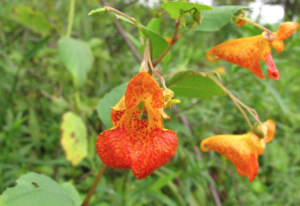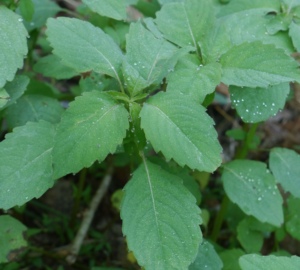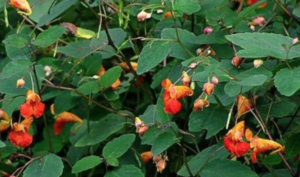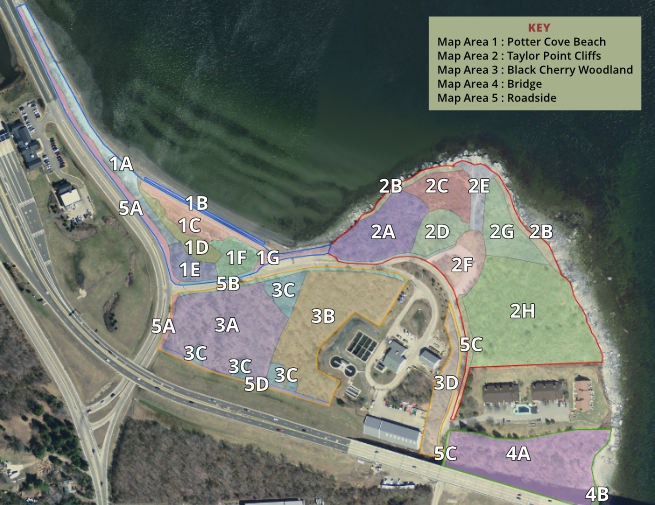Common Name: Jewelweed, Spotted Touch-Me-Not
Specific Name: Impatiens capensis
Known Occurrence at Taylor Point:
Map Areas: Beach 1E, Woodlands 3A
Category: Native, Herbaceous Plant

Ecological Considerations:
Impatiens capensis, commonly known as Jewelweed or Spotted Touch-Me-Not, is a self-seeding annual herbaceous plant that grows 3 to 5 feet tall. The flowers are orange (or sometimes yellow) with a three-lobed corolla; one of the calyx lobes is colored similarly to the corolla and forms a hooked conical nectar spur (tubular elongations of petals and sepals of contain nectar) at the back of the flower. The stems are somewhat translucent, and succulent.
Seedlings sprout in early spring and reach maximum size by August. Flowering begins in mid-summer and continues until frost kills the plant. The seed pods are pendant and have projectile seeds that explode out of the pods when they are lightly touched, if ripe, which is where the name ‘touch-me-not’ comes from.
The showy orange flowers of jewelweed are cross-pollinated by insects and hummingbirds who are attracted to the nectar spurs. Jewelweed also produces less conspicuous flowers that never actually open and which fertilize themselves producing seeds without ever exchanging pollen with another flower. These flowers, called cleistogamous flowers, are very small and are borne near the bases of the leaves. Research has shown that seeds produced by the showy, cross-pollinated flowers grow into larger, hardier plants, but the cleistogamous flowers also produce viable seed.
Jewelweed is commonly found in moist, semi-shaded areas and often forms dense, pure stands in forests and around the forested edges of marshes and bogs. Jewelweed also colonizes disturbed habitats such as ditches and road sides. It can be an aggressive competitor in its favored habitats, and is one of the few native North American plants that has been shown to compete successfully against garlic mustard (Alliaria petiolata), a non-native invasive weed.
Juice from the crushed stem is said to alleviate the symptoms of poison ivy and stinging nettle
Map areas where this plant can be used for revegetation:
Areas dominated by Garlic Mustard such as Bridge 4A, and Bridge 4B.
Propagation Mechanisms/Strategies for Encouraging its Establishment:
Jewelweed can be propagated easily by direct sowing of fresh seed in early fall. Once established, a patch of jewelweed will maintain itself through annual seed production.
Best Planting Practices/Options and Pros and Cons of Options:
Key Issues Regarding its Ecology:
Associated Ecological Benefits:
Jewelweed attracts pollinators including bees, hummingbirds and butterflies.
Availability of Locally Sourced Seeds and Plants:
Case Studies of Native Plant Establishment Efforts/Lessons Learned:
Additional Photos:


Sources cited:
US Forest Service
Go Botany
Wiki Jewelweed
Key Words:
Impatiens capensis
Jewelweed
Spotted Touch-Me-Not
Native
Herbaceous PlantBeach 1E
Woodlands 3A
